Moving from the Shadows – More Distress Inventory Selling and Making it to Market in Southern California. Notice of Defaults Still High. 3 Cities in the Spotlight: Cerritos, Culver City, and Paramount.
The trend in Southern California for the last year was for banks to temporarily try to move homes that were in distress into loan modification programs like HAMP. Yet the programs haven’t met their initial targets. It was estimated that HAMP would help 3 to 4 million homeowners but currently only 228,000 loans are now in “permanent modification†although many re-default within a year. Many banks have now shifted and inventory is now moving its way to the public MLS. This trend is now showing up with many more homes coming to market. It may be the case that banks realize that with the federal $8,000 tax credit ending, and the California $10,000 credit starting in May, they have a short window to move inventory at higher prices because of these juicy incentives.
Southern California MLS Inventory Grows
Another week and another jump in MLS listings for Southern California:
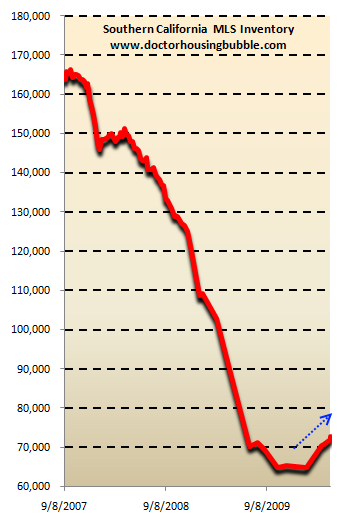
Source:Â MLS
With an inventory bottom being reached sometime in September of 2009, there are now more homes on the MLS for the public to view in Southern California. With sales increasing recently, this means more homes are being added for public view. Part of this shift had to do with many homes simply not qualifying for HAMP in March and April.  Another push has come from banks cleaning house and selectively moving forward with their backlog of inventory. And make no mistake, foreclosure filings are still in record territory.
Nationwide Foreclosure Filings
Last month we hit another unfortunate peak. The number of foreclosure filings reached an all-time monthly high. Now clearly we can have no sustained recovery without this reversing but so far it has been stubborn in coming down. Last month was our first month of decent job growth nationwide since December of 2007. Many of the jobs came from temporary government hiring but others did come from the private sector. The real question will be whether this is just a one month change or a longer trend. Housing needs the employment market to recover. California with a 12.6 percent unemployment rate needs it even more.
As a country foreclosures are still a large issue and will remain that way for a long time. But let us shift to Southern California and examine inventory trends at a micro-level.
Los Angeles Distress – January 2010 vs April 2010
L.A. County is the biggest county in Southern California with approximately 10 million people. I’ve recently started breaking out shadow inventory in three categories but only started gathering this data in January for all three distress categories for each SoCal county. But the bigger trend shows up in this as well:
You’ll notice that notice of defaults fell from January to March but then spiked up in April. This I attribute to banks moving on homes and loans not qualifying for HAMP. Scheduled auctions have steadily declined while some of these homes have shifted to the bank owned category. The pre-foreclosure trend is probably the most important since these are fresh problems in the system. If we can start getting this down, then it is likely we are on to an improving market. These numbers are still extremely high.
Orange County Distress – January 2010 vs April 2010
The trend in Orange County is very similar. You see a dip from January to March and then a resumption of the trend. The same factors impacting Los Angeles are also hitting Orange County. Scheduled auctions did increase for Orange County whereas in L.A. they went down. This is likely due to lenders moving on more expensive properties whereas a few months ago they would have been reluctant.
Understanding Southern California Sales
Part of understanding the trend is looking at how sales occur over a longer timeframe. Let us look at the last decade of home sales in Southern California:
What you’ll notice is a very familiar pattern. Every fall and winter, sales decline due to seasonal factors and then perk up in spring and summer. From 2000 to 2006 the pattern seemed clean with little noise. I’ve added a 12 month moving average trend line in red to show where the break occurred. Sales cracked in early 2006 and broke this six year pattern. The sales low seems to have hit in late 2007. But you’ll notice that a new pattern is being set but at a much lower rate. For example, we have yet to see a 30,000 sales month even though this was common during the housing bubble days. In fact, we haven’t even seen a 25,000 sales month. It’ll be interesting to see if the $10,000 California tax credit is enough to juice the market up in the next few months.
Another caveat to keep in mind is that going back to June of 2008, 40 percent or more of homes sold in each month have been foreclosure re-sales. Last month, that number was 38.4 percent (a very high number). Until we start seeing this number stabilize, the market will still be in a state of flux trying to find a new normal to grab.
3 Cities Examined:Â Cerritos, Culver City, and Paramount
I wanted to examine 3 cities in L.A. County to show what is going on at an even closer level. Let us first look at Cerritos:
Now keep in mind this is looking at data from January to data for late April. One metric that I was looking at was the amount of distress inventory relative to what the public is seeing on the MLS. Cerritos seems to be improving. Notice of defaults, the first stage of foreclosure have fallen by 39 percent in the last four months. And you’ll notice that MLS inventory has increased nearly by the size of the NOD decline. This is good assuming banks are moving on all homes with non-payers (as we know, this isn’t always the case). This means homes are now on the market for people to buy if they wish to purchase instead of sitting in the shadow inventory of banks. The ratio of shadow inventory to MLS is still at 2, but it is better than 4 reached in January. In other words, back in January there were four times the amount of distress inventory compared to what the public was able to see on the MLS. Today it is at two. Also, in that time the median sales price has fallen by $26,000.
Let us look at Culver City, an area we have covered extensively over the years:
Both zip codes in Culver City have seen their MLS inventory increase. However for the 90230 zip code, distress inventory is also up, not a good condition. But overall the near doubling of MLS inventory over these four months has pushed the shadow/MLS ratio down which is good news. The 90232 zip code has also improved. What is even more stunning is that both zip codes have seen their median price go up by $100,000+ over four months. Now for 90232, this is with one home sale so that data doesn’t tell you much. But for the 90230 zip code this is over 8 sales versus 5 back in January. Given Culver City income data this doesn’t make much financial sense but guess what? People are buying even at these prices.
Finally let us look at Paramount:

Now Paramount was a hard hit area in Los Angeles County. Here is an interesting trend. You’ll notice that MLS data hasn’t really changed. This is a common pattern. For lower priced areas including the Inland Empire banks were already moving property back in early 2009. The jump in mid-tier areas like Cerritos and Culver City is a newer trend. You’ll notice for Paramount that distress inventory is declining but so are sales. Sales have fallen by half but this is probably because of the current market price. Conditions are improving but I would expect prices to trend lower.
So where are we heading? Hard to say at the moment since we have significant noise with the federal tax credit ending and with the $10,000 California tax credit starting, we’ll have to wait a few more months to see if the market can stand on its own two feet. People think that the markets can continue to have unlimited funding backed by the government. This is not true. Just look at Greece (or even at our own state budget issues). At a certain point, an event takes place and borrowing is no longer as cheap as it once was. This will happen and it is only a matter of time. Too much debt is out in the system but for the moment, Southern California has fallen into a trend. The above data helps put things in perspective and also shows that the market can only stabilize with massive government support. Will that support continue indefinitely?
Did You Enjoy The Post? Subscribe to Dr. Housing Bubble’s Blog to get updated housing commentary, analysis, and information.
Did You Enjoy The Post? Subscribe to Dr. Housing Bubble’s Blog to get updated housing commentary, analysis, and information

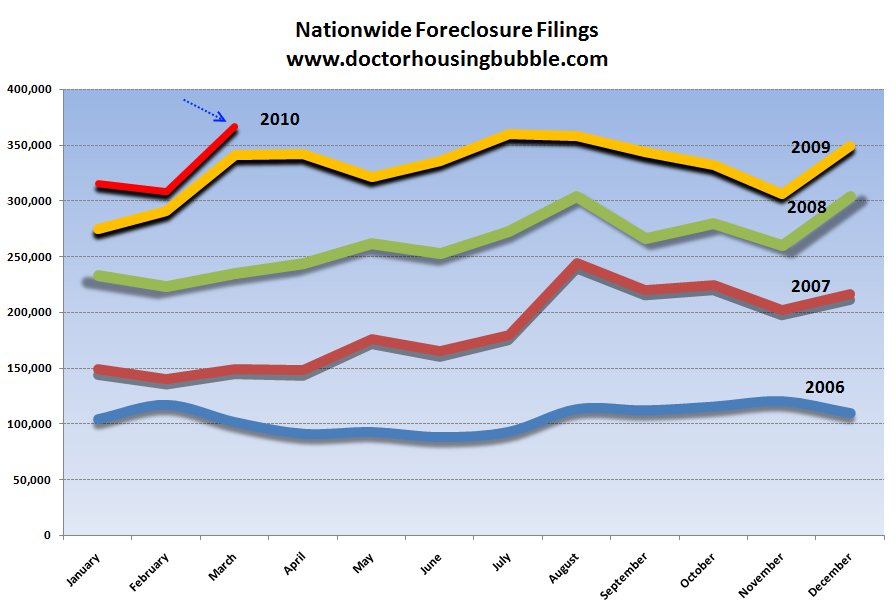
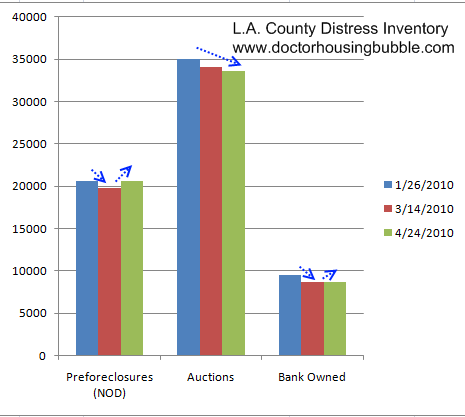
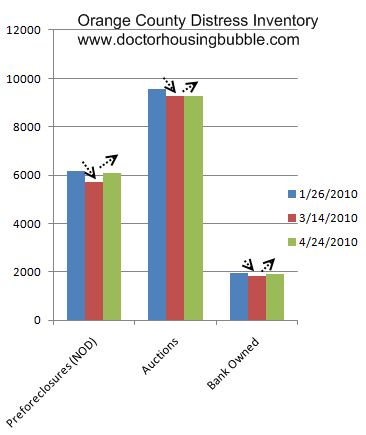
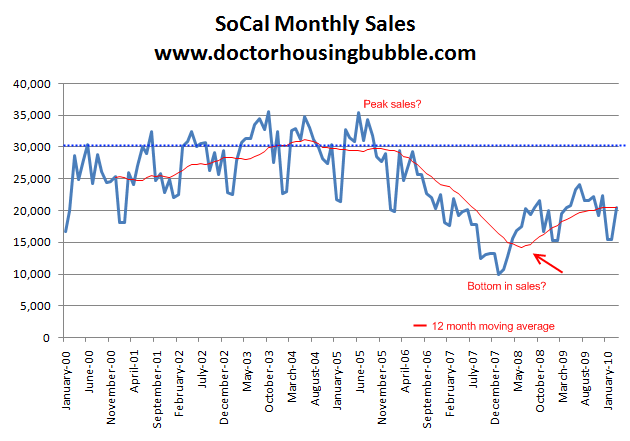


 Subscribe to feed
Subscribe to feed






21 Responses to “Moving from the Shadows – More Distress Inventory Selling and Making it to Market in Southern California. Notice of Defaults Still High. 3 Cities in the Spotlight: Cerritos, Culver City, and Paramount.”
Apparently there is 9 years worth of inventory currently in the US:
http://www.dailymarkets.com/economy/2010/04/24/9-years-worth-of-homes/
If the 10 T Bill clears 5% and sticks there….a lot of things will start down the discount road. Any leveraged asset will have to go down in price.
1.) Inventory of So.Cal homes according to the graph is heading up
2.) Nationwide foreclosure filings for 2010 according to the chart are headed straight up, not to mention they are at levels much higher than 2006-2009
3.) Home sales for So.Cal according to the graph are still down some 60% percent.
I just don’t see how things are improving. All this talk about increase in median price, rise in existing home sales, pending sales, etc… this is all short term “noise”.
I think it’s going to get ugly
I’m sorry to see that some idiots are buying in Culver- but then, if they’re listening to the same line that some Realtor family members have been trying to feed me, it must be hard not to panic and buy in.
However, like I told my family, people were insisting two years ago that homes listed now for 550-600k would NEVER sell for less than 800k-1mil. So I am willing to hold to our family fiscal responsibility and refuse to buy until/if prices drop to a reasonable level. As your blog has taught me, there’s no shame in renting if it means you’re living within your income.
Nice thirty minute interview of Mr. Mortgage on kingworldnews.com look for Mark Hanson.
Highlights:
Real estate problems to continue for another four years. Sales to drop a lot in July after stimulus. Wouldn’t be surprised if another stimilus progrram is started. Expecting a lot more problems for houses over a million.
All that wonderful job creation–nowhere near letting those employed afford still-propped-up housing prices.
~
It’s staggering to see the fifth claw mark on the foreclosure filings chart. Been watching that on DHB since ’06, and it still takes my breath away.
~
What disturbs me most strongly about all this is that we don’t have a housing “market,” just various bankster-and-government house-selling schemes. The market isn’t allowed to function. Understandably, I suppose. But it boggles the mind how anyone can interpret or propagandize little upticks in this or that chart line as “recovery” or “promise” when the whole system is organically damaged and on life support. It’s the Terry Schiavo housing market. Look! She smiled!
~
Or more like Frankenhousing. A stitch here, a corpse scrap there, apply some jolts and lighting bolts. IT’S ALIVE!
~
rose
Here in Chicago it’s so darn sad to see seller one sell a rehabbed bungalow for $750,000. While the bank (seller #2) tries to unload their real estate owned property for about half that! I went to an open house on Sunday and they were trying to sell their rehabbed bungalow for three quarters of a million dollars.
I also want to state it is kind of repulsive to see some people going into an open house only to insult the realtors and the sellers. Not all realtors are bad and not all sellers were greedy bastards who got in over their head. Does it feel for me to be right? Heck yes! But should I gloat over it and remind people on the opposite end how stupid they are? Of course not!
Good for you Susan! We’ve been on the fence since this whole fiasco started, and wow what an education!
I think that just as long as it took (home prices) to rise and peak from the original prices in 2000, it will take just as long to bottom and drag. Its a cycle, different but just a cycle.
Real Estate agents are always gonna preach the good word about housing, they need to keep paying there overpriced company cars and keep there kids in private school.
Dont just take any advise…Do your homework!!
We moved to So Cal Jan 2009 and will continue to rent for $5k/month until RE is allowed to function freely! Now we have a couple of million $ in savings (@ 4 banks earning < 1%!) and make $500k+/yr., so please tell me again how this is all good for the economy?! Not to mention that Prop 13… it could be years and years!
Less doom and gloom than normal. I still see a lot of houses that appear vacant and not for sale in the Inland Empire. The type that have overgrown or dead lawns but no for sale sign up. I also know many people that are finally getting pretty close to losing there house after 12-24 months of free rent. I think household formation is too low for the inventory to get absorbed with the lack of employment for people getting out of college. It will be an interesting year if the government really does finally take the training wheels off.
Some comments:
I see the sharks are circling (Goldman Sachs). But along the lines of “be care what you wish for,” this process needs to proceed carefully, or, the individual investor needs to take measures to protect against a sustained market decline should the technical signs arise. Why? At one time GS comprised 70% of the volume on the NYSE. Should that decline sharply, if the big six banks merely stood aside and refused to buy, the market would likely free fall.
They have assets equivalent to 60 percent of our gross national product. And to put this in perspective, in the mid-1990s, these six banks or their predecessors, since there have been a lot of mergers, had less than 20 percent. Their assets were less than 20 percent of the gross national product.
In the post industrial paradigm Wall Street ‘is’ the economy. Wall Street may kindly remind us of this fact by simply doing nothing as the market falls.
This system needs to be dismantled as carefully as one would defuse live ordnance. If this is done precipitously this bomb is going to hurt many when it explodes.
The system as it stands is doomed but how it unravels and on what political party’s watch it occurs and therefore upon whom the blame will fall will be attempted to be controlled on both sides of the aisle.
In essence, fraud, embezzlement and corruption of the political process are the only profitable businesses left on Wall Street.
The same can be said of the housing market: without gaming the system, the housing market would go into a free-fall. This holds true not just for the mortgage lenders and Wall Street but also for the American public, many of whom are happily complicit in the fraud perpetrated by the mortgage packagers and lenders, as described by southern Nevada correspondent B.K.:
During the boom years, many (in fact, most) people purchased more than one home. In order to get around the “primary resident” issue (a.k.a. “wink and a nod” clause), contracts were drawn-up under the name of a sister, father, family dog, whatever.
Now – these “investors” are not simply living in one of their primary residences rent-free – they are also collecting rent on the other homes that they stopped making their mortgage payments on last week, month, or last year! This is the reality here in Las Vegas; it is the norm.
When you looker deeper into the economic ramifications of this ongoing housing mess as it relates to consumer spending, you begin to see … the Deadbeats are so happy to get “free” money on their many homes, they offer attractive deals to tenants. A property that might normally rent for – say – $1,500/mo, is being offered for $1,000/mo. Now that puts extra money in the tenants’ pockets to spend on the economy as well.
Stop the gaming, fraud and lying, and you gut the U.S. economy, which has grown dangerously dependent on Wall Street and housing for its “growth” and stability. Cripple the gaming which produces the out sized profits, and you cripple both Wall Street and housing, which would then eviscerate the stock market and the sick-unto-death U.S. economy.
Defusing the incentives to game the system is literally like defusing a very large, very volatile, very unstable weapon of mass destruction.
I say it can’t be done. The gaming mentality is now so deeply woven into the U.S. economy and culture that it is akin to a parasite so interconnected with its host that killing the parasite will also kill the host.
This is how empires dwindle, grow vulnerable, and then collapse: the productive are taxed while the wealthy game their way out of paying their equitable share, while the status quo (the State/Plutocracy partnership) showers bread and circuses on the unproductive to buy their silence and complicity as the Oligarchy/Plutocracy loots and ransacks what is left of a productive economy and culture.
DHB
It appears that you are trying to change your stand “So where are we heading? Hard to say at the moment” as I remember not too long ago there was another episode on Cerritos and you were very convinced that renting is better option in Cerritos. Now you are hinting that things will get better in Cerritos. So my point is that we are getting so many conflicting reports about the housing market and don’t know what to do. I am renting in Cerritos and can tell you that houses are selling like hot cakes.
Make no mistake, when I say the market is improving I meant that the shadow inventory ratio in Culver City and Cerritos is getting better. That doesn’t mean you should buy in these areas (in fact you really shouldn’t at least at current prices). I still believe prices are too high but in terms of banks bringing properties to market, we are seeing more momentum in this regard and MLS data is growing as the above chart shows.
>>
As a simple rule of thumb as I have said for years, don’t take on a mortgage that is more than 3 or 3.5 times your annual household income. For the median priced home in Cerritos this means a household income of $180,000 and for Culver City of $209,000. From income data in these areas, we are far from those metrics.
Thanks for clarification. My lease is coming up in July and when I do the math:
I can rent a 1200-1500 Sq. feet home for 2100-2400/month. Considering I am a conventioal buyer with 20-30% down and some cash in reserve, Does it make sense to buy 1200-1500 sq feet home for 510-550K in Cerritos. My biggest concern is that if I signed 1 year lease and thing starting falling who knows what will happen to US dollar OR I might miss the boat again as I did in March 2009 when house prices were at the lowest level and they went up in 6-7 months.
Thanks,
@js: The only boat you missed by not buying a year ago was the Titanic. It might have been very exciting initially, (ala seeing Kate Winslet’s boobs and plowing her in some car) but you would have ended up underwater for a very long time afterward.
Its is good to see you all people and I even see Dr housingbubble’s comments 🙂
Ya, just waiting is the best bet for now and hang on for your seat belt…. Summer of 2010 until Fall of 2011 will be interesting time… Have a nice day!
I’m hearing reports from numerous unconnected sources at fairly significant positions in a variety of major financial institutions, that massive amounts of inventory are coming to the market over the next few months…and it has already begun as Dr. Housing Bubble points out.
With the final federal tax credit expiring (until they possibly create a new one later this year when the bloodbath REALLY picks up), the banks will be dropping everything in the crappy to mediocre areas as well as the garbage in the mid to prime areas. They will mostly hold back everything in the prime areas, however. Ultimately, this won’t help the prime areas because there will be so much inventory in alternative areas that it will drag down everything that has been artificially propped up.
Hold on to your butts…just keep track of the MLS particularly in terms of REO, FCs, and bank approved short sales because according to sources these numbers will begin jumping over the next week or so…
DHB… Do you think your 3 to 3.5 times income # should be revised with the current trough in interest rates? I don’t think buying is sensible in most areas (including the IE) but to keep your numbers in place with historical norms, with interest rates at nearly half of their historical trends, shouldn’t that multiplier be close to 5?
Once again not saying buying is a good idea (I’m saving like the dickens and plan to buy cash in a couple years, cheap house, paid for, less stress 🙂 but that multiplier should be higher shouldn’t it?
js………
90% of Cal homes will drift down for a long time like the Dr. states. Places like Cerritos are being bought up by cash or most all-cash buyers, so that will be your competition. It’s a tuff call. Houses in the goodie areas are usually sold to other banks, then quietly sold at higher prices. I have seen folks grease the banks or the the realtor representing the bank to get a nice foreclosure property.
In an area like that, I would jump on a good deal on a regular sell, but it will be tricky. Remember, areas where the local culture saves money and abstain from credit cards, drop very little even these days. Just look at Arcadia ,Temple City, or Sierra Madre. Several places on the west-side or Pasadena will still drop for there are many credit crunch idiots who still occupy the homes.
@ waiting2buy
So why are you in here commenting? Some people are so pathetic they honestly believe their own lies.
@swiller
Nice insight. Kind of like religions. What would happen to all the televangelists if all the idiots figured out what the game was and quit drinking the koolaid. We’ve become fox-zombies because if feels better than facing the truth.
Europe’s not going down in a vacuum. The sucking sound you hear is getting louder. Gotta keep the game going. What else is there?
Buffet came to GS’ rescue. What does that mean?
Maybe it’s a house of cards, but it’s the only house we got.
Leave a Reply